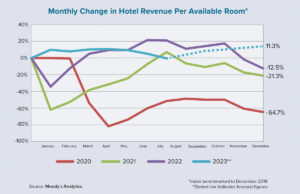A debate is raging right now regarding the future of office space. Some believe that office landlords are the buggy whip manufacturers of the 21st century, clinging to a doomed business model rather than adapting to change. Others are confident that the post-pandemic world will look much like the pre-pandemic environment as tenants rediscover what drove them to spend money on office leases in the first place.
The facts on the ground remain unclear and each side has evidence to support its view. The future of office space is the most interesting unknown facing the commercial real estate market, and the stakes will be high for mortgage lenders, brokers and investors in the coming months and years.
There are those who think that central business districts (CBDs) are poised to do well, reasoning that trophy assets in prime locations will be winners in an era of uncertain demand. Others are convinced that suburban offices will outperform as tenants look for less density and shorter commutes.
To some, the relevance of U.S. gateway cities — New York, Chicago, Boston, Washington, D.C., San Francisco and Los Angeles — will inexorably decline as tenants migrate to lower-cost, lower-density locations. These markets, others note, have tremendous advantages that will continue to draw tenants and premium rent prices.
Some seem certain that coworking companies represent the future, despite the travails of WeWork. Others look at the big coworking names and are reminded of AOL and Netscape — firms that were early pioneers in recognizing that the internet would become a monumental global phenomenon but were unable to capitalize on it commercially.
Here’s one answer based on what we have seen so far: Pick the geographic markets that are prospering and identify what these markets have in common. Do the same with the markets that are struggling. Beyond that, at this stage, it is impossible to generalize about the office market.
Pick the geographic markets that are prospering and identify what these markets have in common. Do the same with the markets that are struggling.
Spotting trends
Commercial mortgage brokers will likely benefit from understanding the demographic trends that are driving marginal demand. Within a given metro area, however, lenders may prosper by returning to their roots and underwriting specific assets on a deal-by-deal basis. Preconceptions about suburban properties versus those in CBDs may not be helpful in such an ambiguous environment.
Much has been written about the COVID-19 pandemic’s intensification of the trend away from high-cost gateway markets towards alternatives in Texas, as well many Southeast and Mountain West metros. Anyone living in Austin or Raleigh is struck by the number of out-of-state license plates on the roads, and available data supports these anecdotal observations.
As CBRE put it in its first-quarter 2021 office leasing report, “persistently low leasing velocity further weakened market fundamentals, producing one of the lowest quarters for demand on record. Larger, more expensive coastal markets were affected more than lower-cost and high-growth markets like Atlanta, Denver and Dallas.” These lower-tax, business-friendly markets were growing consistently before the pandemic and few dispute that the pandemic has accelerated these trends.
In 2020, California’s population shrank for the first time since it became the 31st state in 1850. Meanwhile, the top-five states for population growth last year were Texas (374,000 new residents), Florida (241,000), Arizona (130,000), North Carolina (100,000) and Georgia (81,000). In the past 10 years, Texas added 4 million people and Florida grew by almost 3 million, while North Carolina and Arizona added about 900,000 and 800,000 new residents, respectively, according to the U.S. Census Bureau.
It seems fairly obvious that commercial mortgage lenders and brokers would benefit from focusing on these markets — and indeed they are. While office properties around the country are seeing an increase in short-term renewals from tenants who are already located in a given market, booming Sun Belt markets have been benefiting from large-scale, multimarket searches for long-term corporate relocations.
An unclear future
Beyond these top-down demographic trends, it is difficult to predict what types of office assets will prosper. Older suburban office parks, which encircle many sprawling Sun Belt cities, were commonly wrestling with oversupply before the pandemic. Many tenants in these Class B and C properties are professional-services companies, such as local law firms, accountants, consultants and engineering firms. The largest fixed cost for these businesses is their office lease and it seems likely that many of them are reconsidering their space needs.
Yet some suburban office landlords are raising rents and have a waiting list of prospective tenants. These landlords generally own well-located assets in established, prosperous suburbs where supply is constrained, and from which the commute to the traditional CBD is lengthy and unpredictable. Demand for this kind of space comes from tenants that still want a traditional office — and would prefer an environment with food, drink, shopping and entertainment options — but would like to reduce or eliminate their commute.
It also is difficult to predict demand in the traditional CBDs. In general, they have suffered during the pandemic for reasons of which all market participants are aware. Yet here, too, there are some assets that are thriving. These properties demonstrate strong fundamentals as newer, well-located buildings with good amenities in healthy growth markets. There will likely be tenant interest in amenities such as air purification systems, touchless entry points and touchless fixtures in restrooms.
Demand for flexibility
Concerns about the safety of working in close quarters with a rotating group of strangers dealt a heavy blow to coworking spaces, which many pundits consider a casualty of the pandemic. But the most important driver of coworking is flexibility, and the pandemic has certainly boosted demand for this.
Many tenants are attracted to short-term leases along with the ability to lease more or less space as needed while facing uncertainty about the composition of their workforce and the number of staff who will work from home. Tenants with large national sales organizations and small regional offices spread around the country, for example, may start to offer these dispersed sales-team spaces in a coworking location along with the option of working remotely.
This doesn’t mean, however, that the large coworking specialists are sure to be winners. Local and regional coworking companies, large office landlords, brokerage firms and even individual building owners can offer similar options. There may be an increasing realization that what coworking tenants want most are well-run, well-maintained facilities.
For many coworking tenants, however, cost is a primary factor and the national players are easy to undercut in any given market, since larger players have tended to lease space in trophy buildings. Even with major tenants that care more about a one-stop solution and strong operations than the lowest possible price, the established players must compete with landlords such as Tishman Speyer and Boston Properties, and brokerages such as CBRE are entering the market with capital and scale.
Accordingly, at this stage in the post-pandemic recovery, the Sun Belt markets are clear winners. With these markets, however, mortgage lenders and brokers need to look from the bottom up at the specific characteristics of a given asset. Coworking is here to stay, but the new supply is significant. The pandemic’s wild ride has yet to stop. ●
Author
-

Lee H. Roberts is managing partner of SharpVue Capital, a private investment management company based in Raleigh, North Carolina. He has spent more than 20 years in real estate finance and investments, including roles in private equity, investment banking and commercial banking. He previously served as budget director for the state of North Carolina, where he led an effort to rationalize the state’s real estate portfolio.




